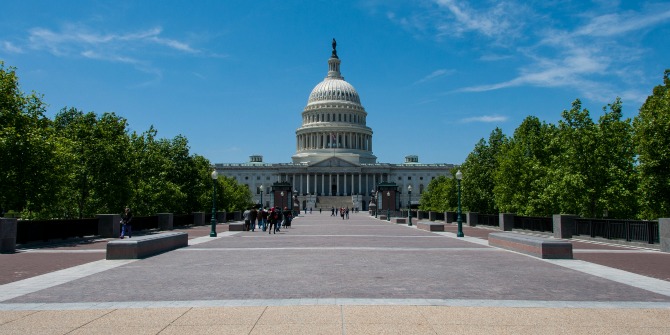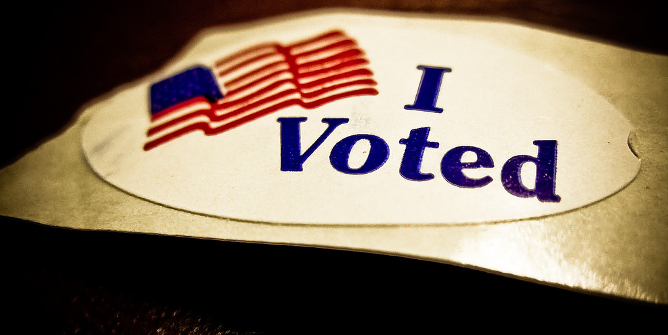 Over the past four decades, the American electorate has changed dramatically. As a result of these changes, Alan Abramowitz argues that we have entered a new and fundamentally different era of competition in presidential elections. The key features of this new era are a close balance of support between the two major parties, a strongly partisan electorate, and a high degree of stability in voter preferences and in the outcomes of elections at the national and state levels. Just as is important, is the growing Democratic advantage in both the national popular vote and the Electoral College due to changing demographics.
Over the past four decades, the American electorate has changed dramatically. As a result of these changes, Alan Abramowitz argues that we have entered a new and fundamentally different era of competition in presidential elections. The key features of this new era are a close balance of support between the two major parties, a strongly partisan electorate, and a high degree of stability in voter preferences and in the outcomes of elections at the national and state levels. Just as is important, is the growing Democratic advantage in both the national popular vote and the Electoral College due to changing demographics.
This article is part of a collaboration with the PS: Political Science and Politics symposium on US Presidential Election Forecasting. Click here to read other posts in this series.
Election forecasters generally have a short-term time perspective and that is perfectly understandable. We are concerned with predicting the outcome of one election at a time. In making our forecasts, we therefore focus on factors that can contribute to an accurate prediction of each party’s share of the vote in a particular election. However, by focusing on individual elections and short-term forces, forecasters may be missing long-term trends that are profoundly altering the nature of electoral competition in the United States.
Over the past four decades, the American electorate has changed dramatically. As a result of these changes, we have entered a new and fundamentally different era of competition in presidential elections. The key features of this new era are a close balance of support between the two major parties, a strongly partisan electorate, a high degree of stability in voter preferences and in the outcomes of elections at the national and state levels, and finally a growing Democratic advantage in both the national popular vote and the Electoral College.
 This new era of electoral politics in the United States is characterized by intense competition for control of the White House as well as both chambers of Congress. Of course there have been closely contested presidential elections throughout American history, but there have also been many landslide elections. Of the 17 presidential elections between 1920 and 1984, ten were won by a double-digit popular vote margin. But there hasn’t been a landslide election since Ronald Reagan’s decisive victory over Walter Mondale in 1984.
This new era of electoral politics in the United States is characterized by intense competition for control of the White House as well as both chambers of Congress. Of course there have been closely contested presidential elections throughout American history, but there have also been many landslide elections. Of the 17 presidential elections between 1920 and 1984, ten were won by a double-digit popular vote margin. But there hasn’t been a landslide election since Ronald Reagan’s decisive victory over Walter Mondale in 1984.
Not only have recent presidential elections been considerably closer on average than earlier ones, their results have also been much more stable. It was not unusual in the earlier elections of the postwar era for the margin between the Democratic and Republican candidates to fluctuate widely from one election to the next. However, the four presidential elections between 2000 and 2012 had the least election-to-election variability in party support of any set of four consecutive presidential elections in the past century.
It is no coincidence that the results of recent presidential elections have been unusually close and unusually stable. This recent pattern reflects important changes that have taken place in the American electorate during this time period. Specifically, it reflects the emergence of a closely divided and strongly partisan electorate. In 2012, overall party loyalty set a modern record with 92 percent of Democratic identifiers and 93 percent of Republican identifiers voting for their party’s presidential candidate according to the National Exit Poll.
Both the closer balance in support between the two major parties and the greater party loyalty of voters reflect the outcome of an ideological realignment that has transformed the American party system since the 1960s. That realignment has resulted in a much closer correspondence between voters’ party affiliations and their ideological orientations. The end result of this ideological realignment is an electorate characterized by very high rates of party loyalty and very stable voting patterns.
The recent era of electoral competition in the United States has been characterized by a very high degree of stability in the preferences of voters and, therefore, in the outcomes of presidential elections at the state and local levels as well as at the national level. Not only have the election-to-election swings in the national popular vote been much smaller than in earlier time periods, but the outcomes at the local and state levels have been exceptionally stable.
Only two states—Indiana and North Carolina—switched sides between 2008 and 2012. This was the smallest number of states switching sides in two consecutive presidential elections since the end of World War II. In fact, simply predicting that every state would support the same party in 2012 as in 2008 would have yielded a far more accurate prediction of the 2012 electoral vote than a forecasting model developed by political scientists based on measures of state economic performance. And this naïve prediction would also have outperformed Nate Silver’s highly sophisticated Electoral College forecasting model as late as mid-October, only three weeks before Election Day.
An examination of the results of recent presidential elections also suggests that the Democratic Party now enjoys a modest but significant advantage in both the popular vote and the Electoral College—an advantage that is likely to grow over the next several election cycles. Democratic presidential candidates have won the popular vote in five of the last six elections. Moreover, the success of Democratic candidate in recent presidential elections appears to be due to more than chance factors. The most important explanation for this recent run of success has almost certainly been the rapid growth in the nonwhite share of the U.S. electorate. The nonwhite share of the electorate grew rather slowly between the 1950s and 1980s but has increased much more rapidly since 1992, reaching 28 percent in 2012 according to the National Exit Poll. The steady increase in the nonwhite share of the U.S. electorate since 1992 reflects major demographic changes in the U.S. population, especially the growth of the Latino population. Moreover, this trend is almost certain to continue for the foreseeable future.
The Democratic Party already enjoys a structural advantage in the Electoral College. Eighteen states and the District of Columbia voted for the Democratic candidate in all four presidential elections between 2000 and 2012. Another three states voted for the Democratic candidate in three of these elections including 2012. Together, these 21 states account for 257 of the 270 electoral votes needed to win the presidency. Moreover, three of the five states that have divided their support evenly between the parties in the last four presidential elections—Colorado, Nevada and Virginia—have shown a strong Democratic trend over these 12 years. While both parties now start off presidential campaigns with large numbers of states and electoral votes essentially locked up, the Democratic candidate now starts off with a substantially larger base of electoral votes.
The trends described here do not mean that the Democratic Party now has a lock on the Electoral College. Short-term forces including the state of the economy, the incumbent president’s approval rating and the first-term incumbency advantage still matter. But the long-term trends I describe are real and they are very likely to continue in 2016 and beyond. Based on these trends, we can make three predictions about future presidential elections.
- The national popular vote margin is likely to be close but the large majority of states will be won by a decisive margin and voting patterns will be very stable from election to election.
- The nonwhite share of the electorate, and especially the Latino share of the electorate, will continue to grow. States with large and/or rapidly growing Latino populations will show continued movement in a Democratic direction as Latinos gain citizenship and are mobilized into the electorate.
- Unless the Republican Party finds a way to substantially increase its share of the nonwhite vote, Republican candidates will be at an increasing disadvantage in future presidential elections. This means that Republican candidates will only be able to win these elections if short-term factors tilt strongly in their favor.
This article is based on the paper ‘Long-Term Trends and Short-Term Forecasts: The Transformation of US Presidential Elections in an Age of Polarization‘ appearing in the PS: Political Science and Politics symposium on US Presidential Election Forecasting. Click here to read the other posts in this series.
Featured image credit: Vox Efx (Creative Commons BY)
Please read our comments policy before commenting.
Note: This article gives the views of the author, and not the position of USApp– American Politics and Policy, nor of the London School of Economics.
Shortened URL for this post: http://bit.ly/1jExjlK
_________________________________________
 Alan I. Abramowitz – Emory University
Alan I. Abramowitz – Emory University
Alan I. Abramowitz is the Alben W. Barkley Professor of Political Science at Emory University in Atlanta, Georgia. Dr. Abramowitz has authored or coauthored six books, dozens of contributions to edited volumes and more than fifty articles in political science journals dealing with political parties, elections, and voting behavior in the United States. His most recent book, The Polarized Public: Why American Government Is So Dysfunctional examines the causes and consequences of growing partisan polarization among political leaders and ordinary Americans.







1 Comments